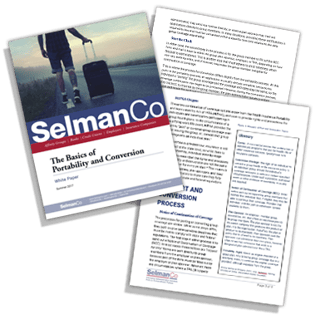We’ve discussed the basics of portability and conversion previously, but this time we wanted to highlight a specific example of how outsourcing this business process to an experienced TPA like SelmanCo can genuinely add value to the service you provide your customers.

Business Case Background Information
SelmanCo is contracted with ABC Insurance Company to assume administration of their Portability and Conversion business. SelmanCo noticed that two issues were arising in the application and initial payment processes that were driving down the ratio of received applications to approved/issued coverages as well as decreasing premiums collected for ABC Insurance Company.
Issues and Problems - Current Approved/Issued vs. Received Application ratio is 59%
Issue 1 - Applicant sends in a quarterly premium due with application and based on the timing for processing the application as well as the effective date of coverage, another billing period has already started. Additional premium must now be requested from the insured to issue coverage and set up the new applicant in the administrative systemIssue 2 - Applicant sends in a payment with application that does not cover a full mode of premium (quarterly, semi-annual or annual). Additional premium must then be requested from the insured to issue coverage and set up the new applicant in the administrative system.
In the two examples above, if the correct premium to issue coverage wasn't received, we would close the application and return all funds received to the applicant. This can create a negative experience for the applicant as well as an increase in appeals to the carrier.
Issue 3 - Service Process: Current procedures do not allow for a phone call to employers or employees to obtain missing information or premium. Standard practice is email notifications to employer groups and a written notification to the employee which includes returning all documents and funds.For all three issues mentioned above, the consequences are the same. They all result in a decrease in percentage of issued vs. received applications and a decrease in premium to the underwriting carrier.
Goal
Increase Approved/Issued vs Received application ratio to 69%, which would result in a 3.5% increase in premium to the underwriting carrier.
Recommendations and Results
1. Obtain approval from carrier to accept less than a modal premium amount at time of application, then bill for the balance upon issuance of coverage.Results:
- More timely processing of applications (increased efficiency for processors and client satisfaction)
- Coverage allotted for period of time that payment provided would cover (security for applicant)
- Increase in retained premium
- Increase in Approved/Issued vs Received application ratio (reduction in number of declined/closed applications)
- Reduction in number of appeals that needed to be processed by administrator and carrier
Results:
- More timely processing of applications (increased efficiency for processors and client satisfaction)
- Increase in Approved/issued vs Received application ratio (reduction in number of declined/closed applications)
- Reduction in number of calls to administrator for application status requests (increased efficiency)
- Reduction in number of appeals that needed to be processed by administrator and carrier (reduced operational costs and increased efficiency)
- Reduction in postage/mailing costs
Within 6 months of implementing these newly approved processes, SelmanCo was able to increase the Approved/Issued vs Received application ratio to 80.56%. That means that the carrier was able to retain more customers than before because SelmanCo made the process more intuitive and easier for all parties involved. A flexible and entrepreneurial insurance administrator like SelmanCo can help identify process improvements, create innovative solutions, and partner in the implementation process, which can ultimately lead to a better customer experience.
Take a look at our white paper on the basics of portability and conversion for more information.




